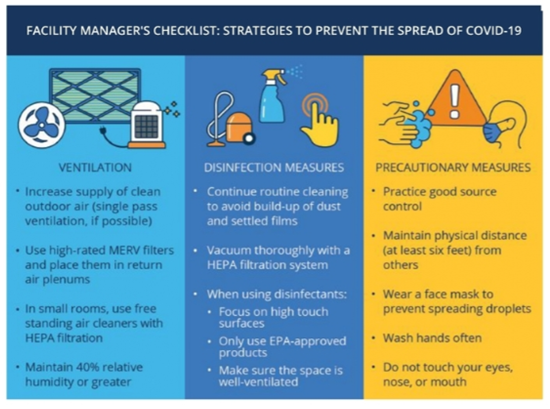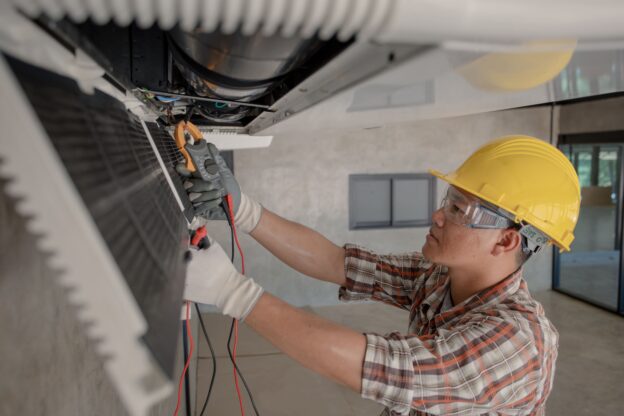This article originally appeared in the March/April 2021 issue of FMJ
As COVID-19 changed the world, facility managers adapted by learning ways to keep commercial tenants and staff healthier and safer. Understanding the science of how COVID-19 is transmitted and the importance of good indoor air quality (IAQ), helps mitigate the risk of infection and widespread sickness at schools, workplaces and residences. During 2020, data, misinformation and changing guidelines were presented, emphasizing the importance of having a clear action plan for maintaining commercial spaces.
What is an aerosol?
Studies have shown that the SARS-CoV-2 virus, which causes COVID-19, can exist as an aerosol and be transported in the air. Aerosols are small solid, liquid (or a combination of both) particles suspended in the air. They have broad environmental impacts that include detrimental health effects because of their ability to be inhaled and deposited in the human respiratory system. Particles can be as small as a few nanometers (nm) to cloud drops of 50 microns (mm) or larger. The smaller particles tend to have greater adverse health effects because they penetrate deepest into the lung and in some cases, are small enough to pass through membranes and translocate to various organs and enter cells. The SARS-CoV-2 virus is small, ranging from 60-140 nanometers (nm).
COVID-19 aerosol transmission
Any process that expels air from the nose or mouth will produce aerosol droplets. Coughing (approximately 3,000 droplets) and sneezing (approximately 40,000 droplets) produce the most. Talking for about five minutes is considered to produce a similar number of droplets as coughing; and sneezing expels the droplets at a high speed, forming a droplet cloud.
Because the virus infects the respiratory tract and can be spread by an infected person who generates liquid aerosol droplets into the air, transmission to the face, eyes, nose or mouth is higher. Turbulence in the surrounding air or the behavior of emitted droplets in one sneeze, as a cloud, can substantially increase the lifetime of the airborne aerosols. Direct air dilution from ventilation, however, can help reduce aerosol levels and remove them from indoor spaces. These droplets can also dry rapidly, decrease in size and eventually deposit on surfaces. Touch surfaces at that point can become contaminated.
Virus droplets and surfaces
There are many factors for FMs to consider with SARS-CoV-2 transmission and commercial interior surfaces. In addition to airborne transmission, the virus aerosol can settle on surfaces and then be physically transported by touching contaminated surfaces. Ambient environmental conditions (e.g., relative humidity), variability in particle size and air flow patterns in the region surrounding the person emitting the aerosols make a difference in this complex process, and how quickly they settle on surfaces.
This raises the issue of how long the virus can live once it is deposited on a surface.
Research found that the virus’ ability to survive from hours to days depends on the type of surface with longer duration of survival observed on hard surfaces. There are many factors like viral load, temperature, humidity and available sunlight that affect survivability. However, SARS-CoV-2 has been found to survive for up to 28 days on non-porous surfaces. An increase in temperature reduces survivability significantly. This indicates the need to disinfect hard surfaces like vinyl, stainless steel, plastic and glass with frequent and consistent processes. These materials are often found on work surfaces, touchscreens, phones and other electronic equipment. Porous materials like cotton and other fabrics have reduced survivability because of their absorptive nature.
Safer schools and workplaces
The condition and safety of indoor air environments have never been more important for FMs and their building occupants. Schools and workplaces are often more crowded, and it is a challenge to maintain the recommended six feet of distance between people and to keep surfaces clean.
Chemical and particle pollutant levels indoors are typically two to 10 times higher than the surrounding outdoor air. Humans breath more than 15 thousand liters of air per day, consuming four times more air than food and liquid together. With the combination of crowded spaces and exposure to general indoor pollutants, this can make people more susceptible to viruses like SARS-CoV-2.
The good news is that in schools and businesses, FMs can take meaningful steps to manage IAQ. Good IAQ is not just about limiting the virus that causes COVID-19, but also general indoor air pollution to reduce respiratory and cardiovascular related health problems like chronic obstructive pulmonary disease (COPD), asthma and respiratory irritation. These can be exacerbated by common indoor air pollutants like volatile organic compounds (VOCs) and respirable particles emitted from processes like 3D printing.
IAQ tactics for commercial spaces
Ventilation
Ventilation systems perform two key functions. They provide conditioned breathing air into interior spaces and they dilute and remove pollutants from the air. Effective ventilation and air purification tactics are key tools in preventing the spread of COVID-19. Many factors determine how long the virus droplets can remain in the air before being inhaled by someone else or eventually deposited on surfaces. For example, research found that at a 6-foot height, in still air, the virus-containing droplet can stay in the air for 40 minutes (with possible range of 10 minutes to two days.) This demonstrates the importance of optimum HVAC system performance with good air exchange, air mixing and filtration.
Commercial buildings tend to have larger, more complex ventilation systems. These buildings should increase the supply of clean outdoor air as much as possible. Depending on the system, ventilated air may consist of outdoor air and recirculated indoor air. Single pass ventilation (100 percent outdoor air) is ideal, if possible, so that interior air is not recirculated. Air filtration is also important, so use filters with the highest MERV rating possible and place filters in return air plenums. In some cases, the use of ultraviolet light in the air plenums may help reduce the virus, but care should be taken to prevent occupant exposure. For small volume rooms, free-standing air cleaners with HEPA filtration may be effective in removing small particles.
For optimal IAQ, it is important to maintain 40 percent relative humidity or greater in an interior space, with 40-60 percent best for occupant comfort.
Disinfection Measures
Many commercial cleaning regimens require important disinfection plans, but these can cause harm and produce unintended consequences. Research shows that disinfection plays a role in preventing COVID-19 transmission, but it also has broader health impacts by degrading indoor health quality. Many disinfectants contain VOCs that evaporative into the air (alcohols, phenols, formaldehyde) that can cause short-term health effects including eye, ear, nose and throat irritation, headaches and nausea. Long-term health effects of VOC exposure include liver, kidney and central nervous system damage.
When considering a facility cleaning and disinfection plan, continue routine cleaning to avoid build-up of dust and settled films that may contain VOCs and other particles. Vacuum thoroughly with a HEPA filtration system, and focus disinfection on high touch surfaces (doorknobs, light switches, touchscreens, work surfaces and office equipment controls.) When using disinfectants, only use those approved by the U.S. EPA and use them in well-ventilated spaces and where windows can be opened.
Precautionary Measures
There are key precautionary measures to prevent the spread of COVID-19 into spaces. The most effective way to eliminate exposure to any pollutant or virus is, by what scientists call, source control. This is eliminating the contaminant altogether by not bringing it into a building.
Practically speaking, maintaining physical distance (at least six feet) from others and avoiding contact are proven an effective way to avoid the spread of COVID-19. Also, effective hygiene is wearing a face mask to prevent droplets spreading, washing hands often and not touching one’s eyes, nose or mouth.
By understanding the science behind virus transmission, proper ventilation, disinfection and precautionary measures, FMs can enhance the quality of indoor air and decrease the spread of disease and ensure a safer, healthier tomorrow.










